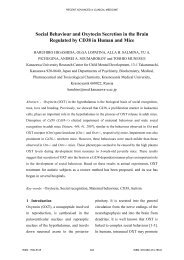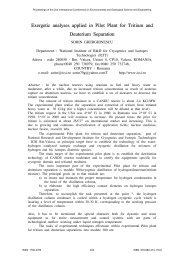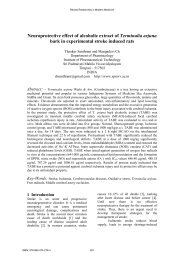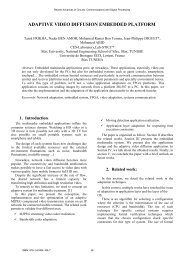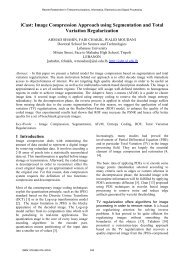<strong>WSEAS</strong> TRANSACTIONS on MATHEMATICSC. Pestano-Gab<strong>in</strong>o, C. Gonz_Lez-Concepcion, M.C. Gil-Far<strong>in</strong>a∞k(1), F(t)= ∑ Fk(t − t0) , F k ∈ Cnxmn , as follows (withoutk=0consider<strong>in</strong>g the equivalent system <strong>of</strong> first-order).Substitut<strong>in</strong>gF (h (t)=∞∑k=0k(k + h)(k + h − 1)...(k + 1)F (t − t ) , h=1, 2...m,k+h 0<strong>in</strong> F (m (t)=A 1 (t)F (m-1 (t)+A 2 (t)F (m-2 (t)+ +A m-1 (t)F'(t)+A m (t)F(t). Later on, we will expla<strong>in</strong> moreexplicitly the recurrence relation for the specificexamples we are go<strong>in</strong>g to study.2 <strong>Matrix</strong> Padé Approximants andRational FunctionsOnce the formal power series for a fundamental matrix(or for a particular solution) is obta<strong>in</strong>ed, it is <strong>of</strong>practical <strong>in</strong>terest to get the theoretic functionassociated to the series. It is evident that this aim isunatta<strong>in</strong>able <strong>in</strong> general and it may only be obta<strong>in</strong> <strong>in</strong>certa<strong>in</strong> problems.In this section we will consider <strong>Matrix</strong> Padé<strong>Approximation</strong> (MPA) results to determ<strong>in</strong>e it there is arational solution and, if so, obta<strong>in</strong> m<strong>in</strong>imum degrees -<strong>in</strong> certa<strong>in</strong> sense- <strong>of</strong> the polynomials <strong>in</strong>volved.We denote as F any formal power series, with matrixcoefficients as follows:∞kmxnF(t) = fk t fk∈ tk=0∑ C ∈C (4)Suppose that there exist matrix polynomials:Q (z) =hhi∑bizi=0hiN h(z) = ∑n iz n ii=0Pg(z) =Dg(z) =g∑i=0g∑i=0ia izidizq ∈Cip ∈Ci∈Cdi∈Cmxnmxnnxnmxmpara i = 0,1,..,hpara i = 0,1,..,hpara i = 0,1,..,gpara i = 0,1,..,gwhere p 0 =I nxn , d 0 =I mxm , F(t)-Q h (t)P -1 g (t)=O(t h+g+1 ) andF(t)-D -1 g (t)N h (t)=O(t h+g+1 ), Q h P -1 g is therefore said to bea right <strong>Matrix</strong> Padé Approximant (right MPA) which isdenoted R [h/g] F ; similarly, D -1 g N h is said to be a left<strong>Matrix</strong> Padé Approximant (left MPA), which is denotedL [h/g] F . We shall use { L [h/g] F } ({ R [h/g] F }) to denote theset <strong>of</strong> all possible approximants L [h/g] F ( R [h/g] F ).As a consequence <strong>of</strong> the def<strong>in</strong>ition we can say that:* R [h/g] F exists, i.e., { R [h/g] F }≠∅, if and only if, thefollow<strong>in</strong>g system has a solution:f h-g+k p g +f h-g+k+1 p g-1 +...+f h+k-1 p 1 =-f h+k , k=1,2...g RS(h,g)* L [h/g] F exists, i.e., { L [h/g] F }≠∅, if and only if thefollow<strong>in</strong>g system can be solved:d g f h-g+k +d g-1 f h-g+k+1 +...+d 1 f h+k-1 =-f h+k k=1,2...g LS(h,g)In both cases it is assumed that f i =0, i0, letjM1( i, j) = ( f i− j+ h+ k− 1) h , k=1,LLM4 (i, j) = (f ) ,j,s+ r−isr i− j+ h+ k− 1 h,k=1M5 (i, j) = (f ) ,Rj+ 1,s+ r−isr i− j+ h+ k− 1 h,k=1M4 (i, j) = (f )s+ r−i,jsr i− j+ h+ k− 1 h,k=1M5 (i, j) = (f )R s+ r− i,j+1sr i− j+ h+ k− 1 h,k=1By convention, if j=0 the rank <strong>of</strong> these matrices is zer<strong>of</strong>or any i∈N.Def<strong>in</strong>ition 4: For any nonnegative <strong>in</strong>tegers i, j, letT1(i,j)=rank(M1(i,j)). We will display these quantities <strong>in</strong>an <strong>in</strong>f<strong>in</strong>ite two-dimensional table, Table 1, where i and jserve to enumerate the columns and the rowsrespectively.Def<strong>in</strong>ition 5: We def<strong>in</strong>e the staired block R1 to be thefollow<strong>in</strong>g subset <strong>of</strong> N 2 :R1={(i,j)∈ N 2 /rank(M1(g,h))=rank(M1(g+k,h+k)) forany k∈N, g≥i and h≥j}..ISSN: 1109-2769 345 Issue 6, Volume 7, June 2008
<strong>WSEAS</strong> TRANSACTIONS on MATHEMATICSC. Pestano-Gab<strong>in</strong>o, C. Gonz_Lez-Concepcion, M.C. Gil-Far<strong>in</strong>aAlthough this set seems rather abstract, the mean<strong>in</strong>g <strong>of</strong>"staired" becomes clear observ<strong>in</strong>g Tables 1 <strong>in</strong> examplesbelow.To beg<strong>in</strong> with, we can propose a method, us<strong>in</strong>g Table 1,to determ<strong>in</strong>e whether or not a matrix series stems from arational function. This can be set out as follows.2.1.1.1 RationalityF is rational if and only if <strong>in</strong> the bottom right part <strong>of</strong>Table 1 we can mark at least one NW-SE diagonal <strong>of</strong><strong>in</strong>f<strong>in</strong>ite size where all its boxes have the same value. It isimportant to state that, there are several such diagonals,with their union co<strong>in</strong>cid<strong>in</strong>g with R1. Note that, with<strong>in</strong>R1, boxes <strong>of</strong> different diagonals can have differentvalues. Furthermore, it is assured that if (a,b)∈R1 thenthe formal power series <strong>of</strong> F and [a/b] F is the same.However, (a,b) are not necessarily left or right m.d.In practice, the Table 1 that we can construct is "f<strong>in</strong>ite".However, <strong>in</strong> some applications where a rule for theformation <strong>of</strong> the coefficients <strong>of</strong> the series F is known,certa<strong>in</strong> relations between the matrices that def<strong>in</strong>e theelements <strong>of</strong> Table 1 can help validate the properties toan <strong>in</strong>f<strong>in</strong>ite size. Otherwise, we can only say the availablecoefficients <strong>of</strong> F co<strong>in</strong>cide with the coefficients <strong>of</strong> arational function <strong>of</strong> certa<strong>in</strong> degrees.2.1.1.2 M<strong>in</strong>imality<strong>The</strong> boxes (i,j) such that T1(i,j)∈R1, T1(i-1,j)∉R1 andT1(i,j-1)∉R1 are called corners <strong>of</strong> R1. In particularsituations we can say that a corner <strong>of</strong> R1 correspondswith a pair <strong>of</strong> left or right m.d., for <strong>in</strong>stance:Property 1: If (i,j)∈R1, (i-1,j)∉R1 and T1(i,j)=jn then(i-u,j-v) is not a pair <strong>of</strong> right m.d. for any u, v such that1≤u≤i and 0≤v≤j.Property 2: If (i,j)∈R1, (i-u,j)∉R1, (i,j-v)∉R1, for anyu, v such that 1≤u≤i and 1≤v≤j, and they are not pairs <strong>of</strong>left (right) m.d., then (i,j) is a pair <strong>of</strong> left (right) m.d.2.1.2 Table 2: M<strong>in</strong>imalityIf F is rational, there are (and we can f<strong>in</strong>d) certa<strong>in</strong>degrees r and s associated to two pairs <strong>of</strong> matrixpolynomials which represent the function <strong>in</strong> rationalform <strong>in</strong> two ways, that is to say, with the <strong>in</strong>vertedpolynomial <strong>of</strong> degree r, multiplied to the right or left.However, it may be that r and s are neither left nor rightm.d. for represent<strong>in</strong>g F s<strong>in</strong>ce there are cases <strong>in</strong> which,for <strong>in</strong>stance, the function is identical to an approximantL [i/j] F but the approximant R [i/j] F does not exist, orviceversa; <strong>in</strong> this case, rank(M1(i,j))≠rank(M1(i+1,j+1))and thus Table 1 would not provide <strong>in</strong>formationconcern<strong>in</strong>g the left or right approximant. For this reason,we present Table 2 -one for the left and one for the rightapproximant-, whose structure reflects the possiblecomb<strong>in</strong>ations <strong>of</strong> m.d. (left and right, respectively) forrepresent<strong>in</strong>g F.Firstly we present the follow<strong>in</strong>g def<strong>in</strong>itions.Def<strong>in</strong>ition 6: Given (s,r)∈R1, for <strong>in</strong>teger i, j, such that0≤i≤s and 0≤j≤r, let L T2 sr (i,j)=0, if rank( L M4 sr (i,j))=rank( L M5 sr (i,j)), or otherwise L T2 sr (i,j)=1. We willdisplay these quantities <strong>in</strong> a f<strong>in</strong>ite two-dimensional table,Table 2 for left approximant, which has s+1 columnsand r+1 rows.Def<strong>in</strong>ition 7: We denote as a staired block L R2 sr , with(s,r)∈R1, the follow<strong>in</strong>g subset <strong>of</strong> N 2 :L R2 sr ={(i,j)∈ N 2 /0≤i≤s, 0≤j≤r andrank( L M4 sr (i,j))=rank( L M5 sr (i,j))}.To def<strong>in</strong>e Table 2 for right approximant we mustconsider R M4 sr (i,j) and R M5 sr (i,j) <strong>in</strong>stead <strong>of</strong> L M4 sr (i,j) andL M5 sr (i,j), respectively. We only expound the theory forthe left case tak<strong>in</strong>g <strong>in</strong>to account that for the right case itis similar.Property 3: F is a rational function identical to L [q/p] Fwhere q and p are left m.d., q≤s and p≤r, if and only if,L T2 sr (q,p)=0, L T2 sr (q-1,p)=1 and L T2 sr (q,p-1)=1, that is,(q,p) is a corner <strong>of</strong> L R2 sr .<strong>The</strong> system correspond<strong>in</strong>g to the denom<strong>in</strong>ator <strong>of</strong> theelement <strong>of</strong> { L [q/p] F } that co<strong>in</strong>cides with F is:d p f q-p+i +d p-1 f q-p+i+1 +...+d 1 f q+i-1 =-f q+i i=1,2...s+r-qwhose associated matrix is L M4 sr (q,p).<strong>The</strong>n we will consider the results <strong>of</strong> MPA to studypossible rational solutions <strong>of</strong> differential equationssystems and <strong>of</strong> partial differential equations.3 Rational Solutions for <strong>Systems</strong> <strong>of</strong>Ord<strong>in</strong>ary <strong>Differential</strong> EquationsIn order to obta<strong>in</strong> a clear understand<strong>in</strong>g, it is importantto read the follow<strong>in</strong>g remarks relat<strong>in</strong>g to possiblerational solutions <strong>of</strong> the system (1).- Even if A 1 (t), A 2 (t)...A m (t) are not rational there mayexist rational solutions. For <strong>in</strong>stance, the systemtt⎛ e − e + 2 ⎞⎜⎟Y'(t)= ⎜ 2t + 4 2t + 4 ⎟ Y(t)s<strong>in</strong>t − s<strong>in</strong> t + 2⎜⎟⎝ 2t + 4 2t + 4 ⎠⎛has a rational solution, Y(t)= 2t + 4 ⎞⎜ ⎟⎝ 2t + 4.⎠- <strong>The</strong> fact that there exists rational solution does notimply the fundamental matrix is rational. Note thatgenerally the l<strong>in</strong>ear comb<strong>in</strong>ation <strong>of</strong> no rationalfunctions could be a rational function, for <strong>in</strong>stance, ifx(t)= cos t−and y(t)= 2cos t + 8 the l<strong>in</strong>ear3t − 23t − 216comb<strong>in</strong>ation 4x(t)+2y(t) is the rational function3t − 2.- <strong>The</strong> system (1) may have a fundamental matrix withISSN: 1109-2769 346 Issue 6, Volume 7, June 2008




